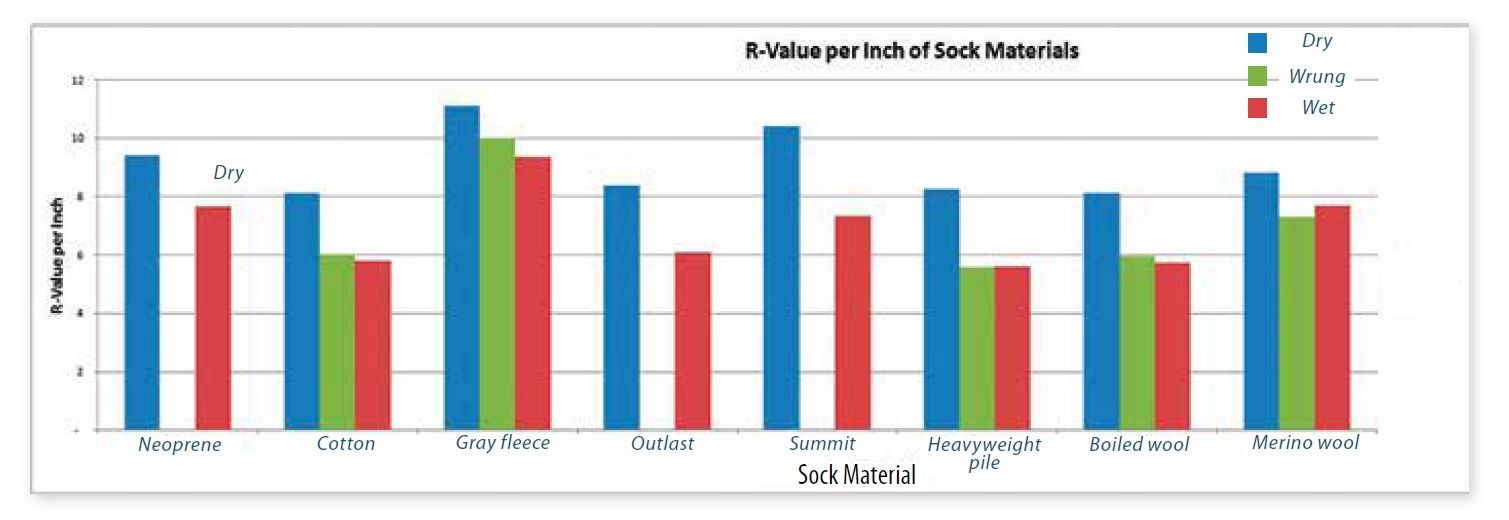“Sailing Socks” (PS January 2019) compared polypropylene liner socks, cotton, fleece, wool and wool blends, both wet and dry. We reported heat loss over time, calculated effective R-value per inch, and observed drying times. We undertook this not just as a review of socks, but also as a way of comparing insulating materials. We wanted to compare these materials as mid-layers and jackets, but construction details vary so widely, accurate comparison would have been impossible. On the other hand, socks are all the same basic shape, with significant differences only in length and thickness.
Somehow we overlooked merino wool, so we’ve done a retest, using the same equipment and procedures. Merino wool, named for the breed of sheep that produces it, is finer, a slightly better insulator, and less scratchy.
How We Tested The Sailing Socks
We measured the thickness of each sock by compressing uniformly between a pair of thin fiberglass sheets and measuring with a micrometer. We then filled a 16 ounce sports drink bottle with 140°F water (uniformly heated in a laboratory hot water bath), slid it into a sock with the top folded over, and sealed that into a 1 gallon freezer bag. They were left on a table at room temperature for two hours, and the temperature drop was measured with a laboratory thermometer.
First we tested them dry, then we soaked the socks for one hour, allowed them to drip off for 15 minutes, and repeated the testing. Finally, we tested them wrung out, since drying may not always be an option and clothing is not always completely sodden.
We then hung them over a line at 65°F, measured weight loss over time, and recorded how long it took before they felt dry to the touch and were at or very near their starting weight (these coincided in all cases).
We tested with the socks sealed in freezer bags to limit the effect of evaporation, since whether sealed inside a boot or under windproof layers, evaporation is limited. Because the freezer bag was not a sealed into a tight fit, there was some evaporation, certainly as much as could be expected in two hours. We felt this was a realistic interpretation of the actual conditions during use. Some readers suggested this methodology understates the effect of evaporation on say, a wet cotton tee shirt in a breeze. Certainly this is true, but we were comparing insulators for underlayers and socks where evaporation is restricted. Heck, we’ve endured wet cotton socks inside leaky Gore-Tex boots; evaporation had nothing to do with the fact that our toes got cold.
We also went for a hike in sub-freezing weather with sodden socks, with merino wool on one and mid-weight fleece on the other, just to see how our feet felt about each. Both fleece and merino wool were loads better than traditional wool or cotton when it came to comfort and blister prevention. Our toes stayed warm with both, unlike wet cotton socks. Although merino wool is less scratchy than common wool, it is still uncomfortable against the skin for some, particularly for top underlayers and hats when wet.
Observations on the Sailing Sock Performance
Not surprisingly, the data show that cotton is a fair insulator when dry, but when it is wet it performs little better than wearing nothing at all. That squares with our experience.
Our study showed that wool and fleece are equivalent insulators (see
table below). They lose some value when wet, but not nearly as much as cotton. Fine weaves (gray fleece and merino wool) are more efficient than coarser weaves (boiled wool, wool blends, and thick pile). As a rule, polyester stinks more and wool is slower to dry.
Merino wool is generally more wind and water resistant than fleece, although this depends on the weave. If worn as a top layer, that is an advantage, but when managing moisture under a windproof outer layer or inside a drysuit, the superior breathability and moisture transport of fleece wins. Some believe fleece is better for continuously active use, while wool is better start-and-stop activity.
Price. Fleece is generally 25-50 percent less expensive than an equivalent merino wool garment. Fleece generally wears better, although this varies with the manufacturer. We have decades-old examples of both.
Conclusion
Cotton is cold when wet. Save it for summer tee shirts. Wool manages moisture by absorbing it without losing insulation value. Fleece manages moisture by wicking it away and evaporating it, without losing insulation value. Merino wool stinks less and fleece has the upper hand on drying time.
On a long cruise, when drying clothes will be difficult, go with fleece. If you are going home every night, Merino may be more comfortable, but this comes down to personal preference.
The method of science is to design a controlled experiment, describe the procedure so that others can repeat it, observe what happens, and the present data. The investigator draws his conclusions, while inviting others to repeat his work and do more of their own. We conclude that merino wool and mid-weight fleece are both good materials, and that the best choice will depend on the application and personal preference.






































I don’t normally sail with sea boots when cruising but prefer sneaker style deck shoes. On a cruise down the US east coast in the late fall I wore a thin merino wool sock covered by a gortex sock and slipped into the sneaker deck shoes. It was a little snug but not so much to lose circulation. I felt much more agile than stumbling around in sea boots.